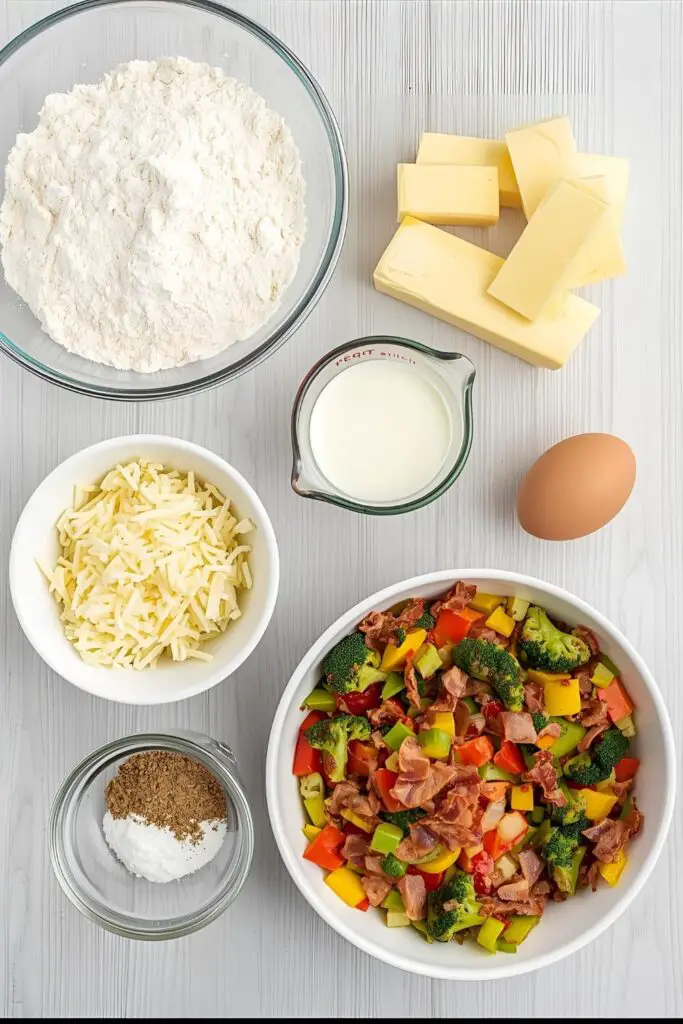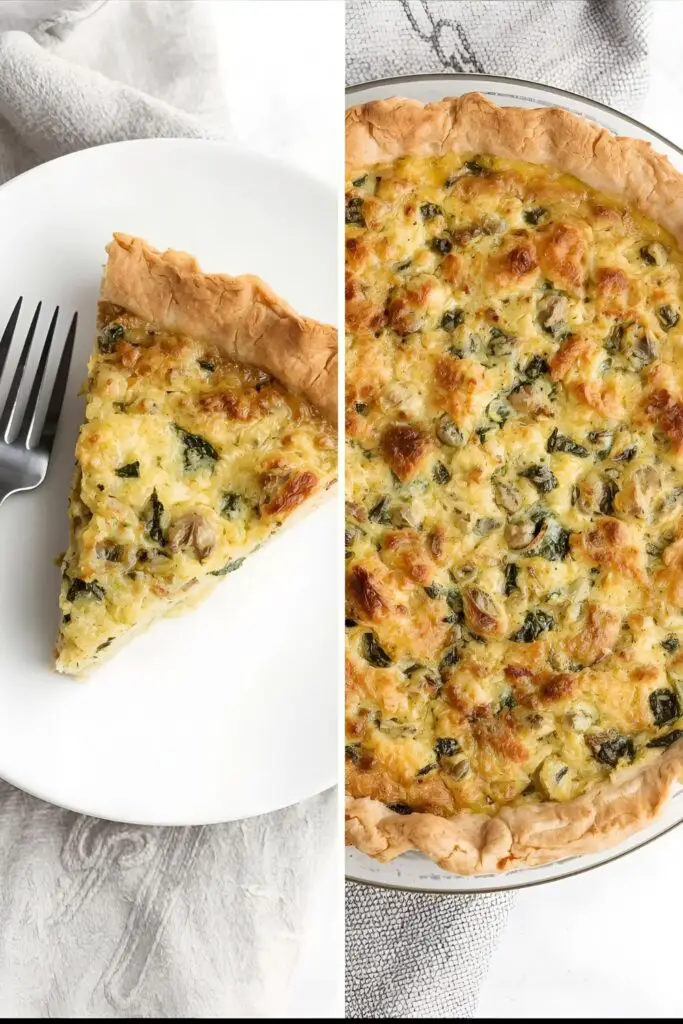Why This Quiche Recipe Is Seriously Awesome
Still humming and hawing about whipping up a quiche? Let me lay down the reasons why this recipe is about to become your go-to for effortless elegance (and tasty leftovers).
First, it’s a flavor chameleon. Seriously, you can customize the fillings to your heart’s content (or to whatever sad-looking vegetables are wilting in your crisper drawer). From classic Lorraine with bacon and cheese to spinach and feta, the flavor combinations are practically infinite.
Second, it’s make-ahead magic. You can bake a quiche ahead of time and serve it warm, at room temperature, or even cold. This makes it a total lifesaver for brunches, potlucks, or those days when you just can’t be bothered to cook.
Finally, it’s way easier than it looks. Sure, it sounds fancy, but the basic formula is simple: crust + eggs + dairy + delicious stuff. We’ll walk you through it, and you’ll wonder why you haven’t been quiche-ing your life sooner.
The Cast of Culinary Characters (Ingredients)
Here’s what you’ll need to create your eggy masterpiece. Don’t worry, you probably have most of this stuff already.
For the Crust (The Flaky Foundation):
- All-Purpose Flour: 1 ¼ cups (about 155g).
- Salt: ½ teaspoon.
- Cold Unsalted Butter: ½ cup (1 stick, 113g), cut into small cubes. Keep it COLD! Seriously, this is key for a flaky crust.
- Ice Water: 3-4 tablespoons. Add just enough to bring the dough together.
For the Filling (The Star of the Show):
- Eggs: 4 large.
- Heavy Cream: 1 ½ cups (about 355ml). You can substitute with whole milk for a lighter quiche, but heavy cream gives it that luxurious texture.
- Salt: ½ teaspoon, or to taste.
- Black Pepper: ¼ teaspoon, or to taste.
- Nutmeg: A pinch (optional, but adds a lovely warmth).
- Your Choice of Fillings (About 1-1 ½ cups total): Here are some ideas:
- Cooked and crumbled bacon or sausage
- Shredded cheese (cheddar, Gruyère, Swiss, feta – go wild!)
- Sautéed vegetables (spinach, mushrooms, onions, peppers)
- Smoked salmon, chopped
- Roasted tomatoes
Your Quiche-Crafting Arsenal
You won’t need a ton of fancy equipment for this.
- Large Mixing Bowl: For making the dough.
- Pastry Blender or Your Fingertips: For cutting the butter into the flour.
- Measuring Cups and Spoons.
- 9-inch Pie Plate: A standard size for quiche.
- Rolling Pin: For rolling out the dough.
- Parchment Paper or Aluminum Foil: For blind baking.
- Pie Weights or Dried Beans: To weigh down the crust during blind baking.
- Whisk: For mixing the custard filling.
- Large Bowl: For tossing the fillings.
Step-by-Step: From Dough to Deliciousness
Ready to get your hands floury? Let’s make a quiche!
Step 1: Whip Up the Crust (The Flaky Foundation)
In your large mixing bowl, whisk together the flour and salt. Add the cold, cubed butter. Using a pastry blender or your fingertips, cut the butter into the flour until the mixture resembles coarse crumbs with some pea-sized pieces of butter remaining. Don’t overmix! Those little butter chunks are what create flakiness.
Gradually add the ice water, one tablespoon at a time, mixing gently after each addition until the dough just comes together. It shouldn’t be sticky.
Form the dough into a disc, wrap it in plastic wrap, and refrigerate for at least 30 minutes. This chilling time is crucial as it allows the gluten to relax and the butter to firm up, resulting in a more tender and easier-to-handle crust. Don’t be tempted to skip this!
Step 2: Pre-Bake the Crust (Blind Baking for Success)
On a lightly floured surface, roll out the chilled dough into a 12-inch circle. Carefully transfer the dough to your 9-inch pie plate, pressing it gently into the bottom and up the sides. Trim any excess dough and crimp the edges with a fork or your fingers for a pretty finish.
Line the crust with parchment paper or aluminum foil and fill it with pie weights or dried beans. This prevents the crust from puffing up during baking.
Bake in a preheated oven at 375°F (190°C) for 15 minutes. Carefully remove the parchment paper and pie weights and bake for another 5-10 minutes, or until the crust is lightly golden and set. This pre-baking, also known as blind baking, ensures a crisp bottom crust that won’t get soggy from the filling. Soggy bottoms are a quiche tragedy.
Step 3: Prepare the Filling (The Flavor Party)
In a large bowl, whisk together the eggs, heavy cream, salt, pepper, and nutmeg (if using) until well combined. Don’t over-whisk; just make sure everything is incorporated.
In a separate bowl, gently toss your chosen fillings together. If you’re using raw vegetables like onions or mushrooms, it’s best to sauté them beforehand to remove excess moisture and cook them slightly. Distribute the fillings evenly in the pre-baked crust.
Step 4: Assemble and Bake (The Grand Finale)
Pour the egg mixture over the fillings in the crust, making sure everything is evenly covered.
Bake in the preheated oven at 350°F (175°C) for 30-40 minutes, or until the quiche is set and lightly golden brown on top. The center should no longer jiggle excessively when you gently shake the pie plate. A knife inserted near the center should come out mostly clean.
Step 5: Cool and Serve (The Moment of Truth)
Let the quiche cool in the pie plate for at least 10-15 minutes before slicing and serving. This allows the custard to set further and makes it easier to cut. Enjoy it warm, at room temperature, or even cold.
Calories & Nutritional Info (Depends on Your Adventure)
The calorie and nutritional content of your quiche will vary significantly depending on the fillings you choose. Here’s a rough estimate for a slice of a basic cheese and vegetable quiche (about 1/6 of the quiche):
- Serving Size: 1 slice (about 1/6 of a 9-inch quiche)
- Estimated Calories: 300-450
- Main Components: Primarily fat and protein from the eggs and dairy, with carbohydrates from the crust and fillings.
- Nutritional Note: Quiche can be a good source of protein and calcium. Loading it up with vegetables can also boost its vitamin and fiber content. Just be mindful of the fat content, especially if using heavy cream and lots of cheese.
Common Mistakes to Avoid (Don’t Let Your Quiche Be a Disaster!)
- Soggy Bottom Blues: This is the ultimate quiche fail. Blind baking your crust properly is the best way to avoid this tragedy. Also, don’t add too many watery fillings.
- Overmixing the Dough: Overworking the dough develops too much gluten, resulting in a tough crust. Mix just until it comes together.
- Not Chilling the Dough: Chilling is crucial for both flakiness and ease of handling. Patience, my friend, patience.
- Overbaking the Quiche: Overbaked custard becomes rubbery and sad. Bake until just set – it should still have a slight wiggle in the very center.
- Adding Too Many Fillings: Overstuffing your quiche can prevent the custard from setting properly. Stick to about 1-1 ½ cups of fillings.
- Forgetting to Season: Don’t underestimate the power of salt, pepper, and that little pinch of nutmeg! Season your custard and fillings appropriately.
Variations & Customizations (Quiche Your Way!)
The beauty of quiche lies in its endless adaptability.
1. Crustless Quiche (Keto-Friendly & Gluten-Free)
Skip the crust entirely for a lighter, keto-friendly, and gluten-free option. Simply grease your pie plate well and pour the egg mixture with your chosen fillings directly into the dish. Bake as directed, keeping an eye on the cooking time.
2. Spicy Kick Quiche
Add some heat by incorporating diced jalapeños, a pinch of red pepper flakes, or a dash of your favorite hot sauce into the custard mixture. Spicy sausage or chorizo in the filling will also do the trick.
3. Mini Quiches (Perfect for Parties)
Use a muffin tin to make individual mini quiches. Roll out your pastry dough thinly and cut out circles to fit the muffin cups. Fill with your desired fillings and the egg mixture, then bake for a shorter time (around 20-25 minutes).
FAQ: Your Quiche Queries, Quelled
Let’s tackle those burning quiche questions.
1. Can I use store-bought pie crust? Absolutely! If you’re short on time or just not feeling the pastry-making vibe, a good quality store-bought pie crust will work perfectly fine. Just follow the package instructions for pre-baking.
2. How do I know when my quiche is done? The quiche is done when the edges are set and lightly golden brown, and the center is mostly set but may still have a slight wobble. A knife inserted near the center should come out mostly clean.
3. Can I freeze a quiche? Yes, you can freeze a baked quiche. Let it cool completely, then wrap it tightly in plastic wrap and then in aluminum foil or place it in a freezer-safe bag. It can be frozen for up to 3 months. Thaw it overnight in the refrigerator and reheat it in a 350°F (175°C) oven until warmed through.
4. What are some good vegetarian quiche filling ideas? The possibilities are endless! Try combinations like spinach and feta, roasted vegetables (zucchini, bell peppers, eggplant), mushroom and Swiss, broccoli and cheddar, or asparagus and Gruyère.
5. Can I make a quiche with just egg whites? While you can, the texture will be quite different – less rich and creamy. You might need to adjust the baking time slightly.
6. Why did my quiche crack on top? Cracking can happen if the quiche is overbaked or if it experiences a sudden temperature change. Try not to overbake it and let it cool gradually at room temperature after taking it out of the oven.
7. What’s the difference between a quiche and a frittata? Both are egg-based dishes, but a quiche typically has a crust and is baked in the oven, while a frittata is usually cooked in a skillet, starting on the stovetop and finishing in the oven, and doesn’t have a crust.
Final Thoughts
There you have it! You’re now officially armed with the knowledge to conquer the culinary world, one delicious quiche at a time. So go forth, raid your fridge, get creative with your fillings, and prepare to bask in the glory of your perfectly baked, subtly impressive creation. Who knew that such a seemingly fancy dish could be so wonderfully… you? Happy quiche-ing!




